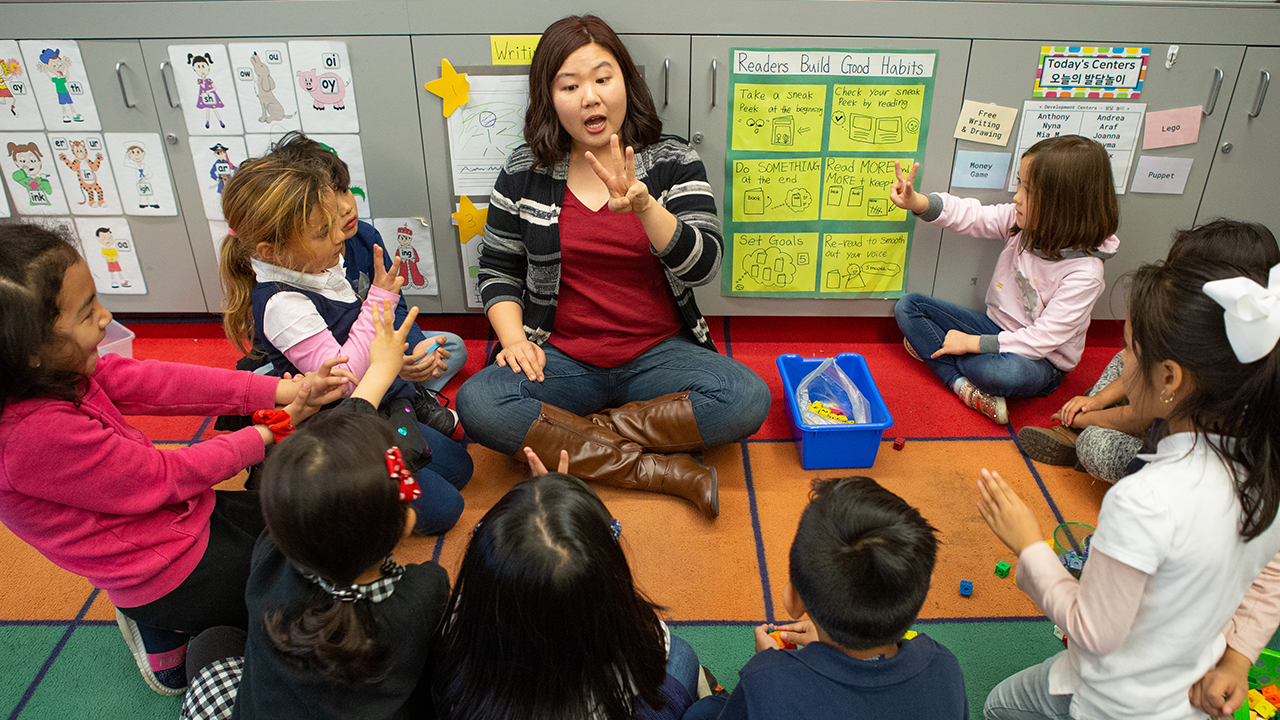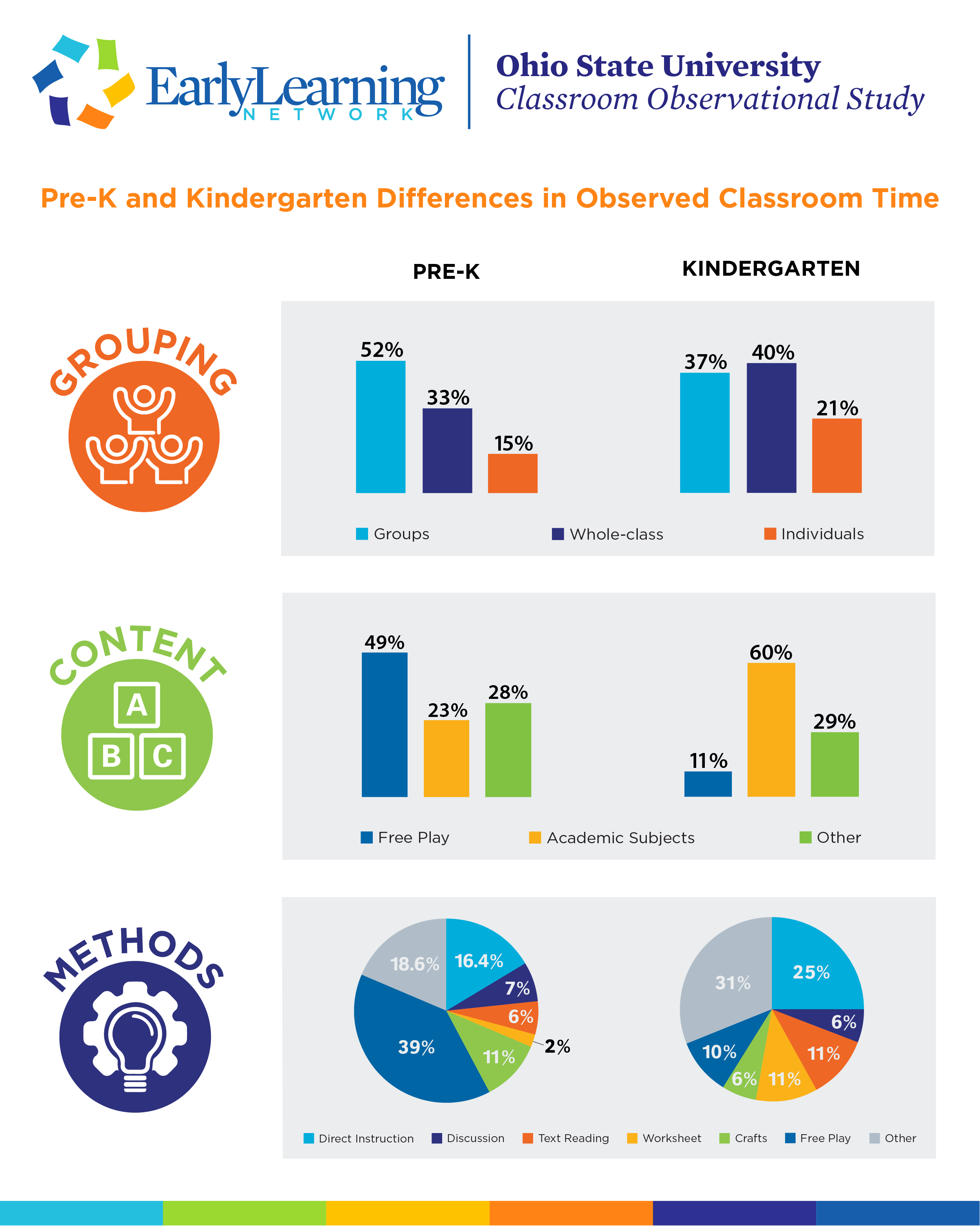
15 Dec Pre-K learning experiences appear starkly different from elementary school
A recent Early Learning Network study led by researchers at Ohio State University found that instructional practices in prekindergarten (pre-K) were starkly different from those in kindergarten through third grade, and that kindergarten appears to be highly academic for about two-thirds of classrooms. Findings also showed kindergarten instructional practices were well aligned with practices used in the older grades.
Why it matters
While there are many approaches to teaching young learners in the classroom, there is little consensus on which approach is best to promote children’s academic and social-emotional development during the transition from pre-K to third grade.
Students’ exposure to strong instructional alignment — the degree of consistency in children’s learning experiences — from pre-K to third grade may help narrow opportunity gaps, and in particular, help children maintain skills gained while attending high-quality pre-K as they advance through school.
The longitudinal study’s findings showed a lack of vertical alignment across pre-K to kindergarten, which has potential to jeopardize students’ long-term success.
There is evidence that skills gained in pre-K diminish when children enter school, and increased alignment of practices between educational settings may address this concern.
“The sharp distinctions found between the pre-K and kindergarten may make children’s transition to kindergarten difficult and contribute to stagnant growth over time,” said Laura Justice, principal investigator, Ohio State University.
In contrast, kindergarten practices in Ohio appeared to be highly aligned with practices used in the older grades.
“While there are many benefits to the academization of kindergarten, and all kindergarten classrooms cannot be viewed monolithically, this finding may signal to some that the academic rigor in today’s kindergarten classrooms, which is akin to first grade, has gone beyond what is developmentally appropriate for children ages 5 and 6,” Justice said.
The study
The study, published in Early Education and Development, examined the extent to which instructional practices in pre-K through third grade are vertically aligned. It included a sample of 1,095 students in 179 pre-K through third grade classrooms in the Columbus, Ohio area.
The Ohio State University research team studied grade-related differences in instructional experiences across three dimensions important for students’ learning:
1. Teachers’ grouping practices: Whole-class, individual and group activities.
2. Academic content: Language/literacy and math.
3. Pedagogical methods: Direct instruction, discussion, text reading, writing and worksheet.
Classroom profiles
Using both variable- and person-centered approaches, pre-K to third grade classrooms were categorized into four classroom “profiles” based on patterns of observed practices:
- Profile 1: Individual Language and Literacy (n = 19, 11%)
- Profile 2: Whole-Class Language and Literacy (n = 90, 50%)
- Profile 3: Whole-Class Discussion (n = 11, 6%)
- Profile 4: Academic-Light Group Work (n = 59, 33%)
The Individual Language and Literacy profile and the Whole-Class Discussion profile were dominated by classrooms from first through third grade (100% and 91%, respectively), with little to no representation of pre-K and kindergarten. The Academic-Light Group Work profile consisted primarily of pre-K (56%) and kindergarten (29%) classrooms.
Key findings
1. Instructional practices in pre-K are considerably misaligned to those in kindergarten across all three dimensions, whereas instructional practices in kindergarten appear to be better aligned to those in first, second and third grade.
2. More than one-half of pre-K and about one-third of kindergarten classrooms fit a profile of Academic Light Group Work, and children in this profile of classrooms showed less growth in reading and math over the academic year compared with other classrooms.
3. There was very little balance to content-area exposure across these grades, with instruction dominated by language and literacy, and to some extent, math, with mediocre attention to science, technology, social studies or the arts.
The Ohio team’s findings replicate a separate Early Learning Network study of pre-K and kindergarten classrooms conducted in Fairfax County, Virginia, with similar and compelling observations:
- Exposure to language and literacy content in pre-K is modest but increases to about one-half of instructional content in kindergarten.
- Exposure to math content in pre-K is mediocre and increases to about one-fifth of content in kindergarten.
- Whole-class instruction in pre-K represents less than one-third of instructional time and increases to 40% of time in kindergarten.
- Free play and center time are abundant in pre-K and scarce in kindergarten and grades one to three.

What this means
The study’s findings highlight the following implications for research, practice and policy:
- Further research is needed to understand the optimal design of kindergarten classrooms — balancing opportunities for creative play and academic skill development— to best meet young children’s developmental needs, as well as strategies that support a smooth transition from pre-K to kindergarten.
- Children in the Academic-Light Group Work profile demonstrated fewer gains in math and reading than those in the other groups, which begs the need to further consider how instructional practices may contribute to (or detract from) the development of early academic skills.
- Language and literacy content dominated classroom content, which is not surprising given the state-level requirements for reading achievement in third grade. This result begs the need to address barriers that inhibit teachers from incorporating more science, technology, social studies and other content into their classrooms. A greater emphasis on science in the early grades may be a way to mitigate achievement gaps.
- Children in the Whole-Class Discussion classrooms had significantly higher growth in task orientation than children in the Whole-Class Language and Literacy and Whole- Class Discussion profiles. It may benefit students to offer more opportunities for structured discussions to enhance students’ higher-level learning and classroom engagement.
What’s next
Overall, the researchers point to the need to enhance practices and policies from pre-K through third grade to promote greater instructional alignment. Enhanced vertical alignment in instructional methods may help children more seamlessly transition across the grades and better serve to maintain learning gains from year-to-year.
“We see this study is an initial step to first understanding alignment across these grades and then to consider how alignment does and does not influence children’s academic and social-behavioral development over time,” Justice said.
Dig deeper
Read the full OSU research paper:
“Academics of the Early Primary Grades: Investigating the Alignment of Instructional Practices from Pre-K to Third Grade” Early Education and Development (2021)
Laura M. Justice, Hui Jiang, Kelly M. Purtell, Tzu-Jung Lin and Arya Ansari, Ohio State University
Additional resources
“Alignment and Misalignment of Classroom Experiences from Pre-K to Kindergarten”
Early Childhood Research Quarterly (2020)
Virginia E. Vitiello, Robert C. Pianta, Jessica E. Whittaker, and Erik A. Ruzek; University of Virginia
ELN policy brief: “Bridging the Gap: Easing the Transition from Pre-K to Kindergarten.”
ELN webinar: “Easing the Transition from Pre-K to Kindergarten.”

